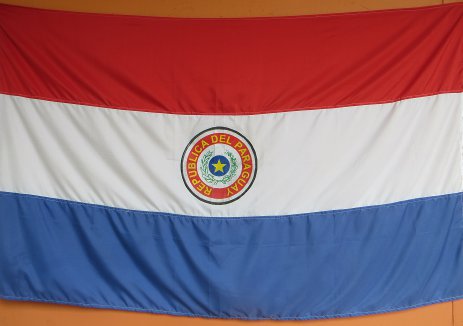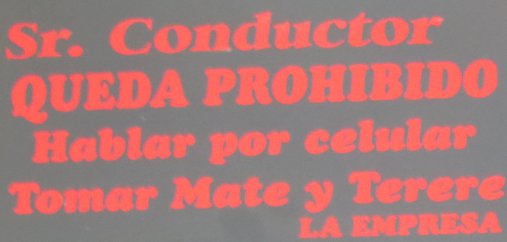Best of Paraguay

We visited Paraguay for 17 days from September 29, 2015 after entering the country by bus coming from Villamontes, Bolivia through the border in El Chaco. This was a long journey of dirt, lots of anti-narcotics check points, and humidity. Sal needed to use his Salvadorian passport to enter Paraguay because Salvadorians do not need a visa and US citizens do. After the drama we had with Bolivia not letting us switch passports, we decided to go consult this situation at the Paraguayan Embassy in La Paz, where a diplomat explained that Sal should be allowed inside Paraguay as a Salvadorian citizen even if he had used his US passport to enter and exit Bolivia. However, he warned us saying that we will most likely face challenges with the Paraguayan immigration officials at El Chaco border. Once we reached the border, Paraguayan officials gave Sal a little trouble, stating that “he was allowed to use only one passport.” Sal explained that he had consulted with the embassy and was assured it was perfectly legal for him to travel with his Salvadorian passport. The Paraguayan officials made us wait a short time, but finally stamped his passport saying “they had made us a favor.” Gisela used her Colombian passport to enter without any problems. We were both given 90 days to stay in the country. At the end, we were pleased with the outcome, regardless of the challenge we met our goal and reached Paraguay, country number 61 in our journey. 😉
During our days in the country we traveled a total of 39.5 hours by bus and even hitchhiked a ride, making stops in Filadelfia, Concepcion, Santa Maria del Aguaray, Laguna Blanca, Asuncion, Encarnacion, and Ciudad del Este. We were happy seeing locals drink Terere (cold yerba mate) and listening to them talk in Guarani everywhere in Paraguay. Even if we could not understand a word of what they said, seeing them preserving their native language and traditions filled us with great joy. For the first time in Latin America, we felt we were in another continent due to the strong prevalence of the Guarani language. Paraguay, from a cultural point of view, is a very unique and interesting country to visit. Since we arrived at Paraguay, the people made us feel welcomed. We loved their friendly demeanor, always open to start a conversation, curious to know where we were coming from, and kind to answer our questions about their country. This was also the same impression that the people in the Paraguayan Chaco gave us. This region’s landscapes and native indigenous reminded us a lot of Australia: very flat, dry, red colored soil with different species of trees and bushes, as well as a notorious issue of alcoholism in males. The only thing that upset us was the Paraguayan bad habit of throwing trash everywhere. We observed this behavior all over the country, it was very sad to see people throwing garbage from the bus windows and in the streets of every town. When we questioned people about their behavior their answer was even more disappointing: “here, it is like that.”
Paraguay is probably the only country that has a solid soup, Paraguayan Soup is similar to cornbread. More of their meals are meat based similar to Uruguay and Argentina. Paraguayans love asaditos (meat skewers), empanadas, and lomitos. All dishes are usually served with boiled mandioca (yuca or cassava). They also make chipa, traditional bread made from cassava flour and cheese. The country also has a few foreign dishes that have come become traditional, such as the delicious lomito arabe, a shawerma wrap from the Arab immigrants, and great sushi from the Japanese community in Encarnacion.
We were also fortunate to drink terere with Paraguayans that were always willing share all over the country. Our most memorable terere drinking experience was during a hitchhike ride of 5.5 hours, accompanied by the life story of the driver. Terere is the traditional Paraguayan drink and a social experience indeed, it is yerba mate with cold water mixed with “yuyos” (different medicinal herbs), perfect for the high temperatures of these territories.

Paraguay has interesting historic and political facts. It was the first country to achieve complete independence from the Spanish colony on May 14, 1811 and the only one that obtained it in a pacific manner without any war or loss of blood. Paraguay has also been the South American nation who suffered the longest dictariorship, 35 years, under General Alfredo Stroessner between 1954 and 1989. Paraguay most known wars were the Triple Alliance War and El Chaco War. The Triple Alliance War was where Paraguay stepped in to help Uruguay from Brazil, but ended up fighting against the alliance of Argentina, Uruguay, and Brazil. The war started in 1865 and ended in 1870 with the loss of significant Paraguayan territory. El Chaco War started in 1932 and lasted almost 3 years. It was initiated by Bolivia in an attempt to gain access to the ocean after having lost the Pacific War against Chile. Paraguay was able to defend its land and won this war.
In present day, Paraguay is a scenario of poverty, marijuana plantations, drug trafficking, and high governmental corruption. While we were in Paraguay students have been holding strong protests for almost a month against corruption at the public university in Asuncion and its main director. Thanks to these protests the director, who had been earning a lot of money for multiple classes he has not taught and had given teaching positions to his unqualified family members, was fired and facing legal charges. All over Paraguay the lack of government investment in its population was sadly evident, such as a very decadent road system that kept forgotten towns even more isolated. We admired the kindness and happiness with which Paraguayans acted regardless of the deep abandonment they faced by their leaders. We were glad for the awakening and advocating taking place by their youth and students, which brings hopes for a promising future for this society to be again one of the greatest of South America.
Our first stop while traveling in Paraguay was Filadelfia, a Mennonite community founded in 1927 in the Paraguayan Chaco by German Protestants that ran away from the Soviet Union Regime during the First World War, because they were forcing them to join the army and their properties were expropriated. We visited the Mennonite’s museums and learned about the history of this colony and their beliefs, which differed from the Catholic Church in very important aspects. The Mennonites believe that baptism should be an act of conscious faith practiced at an adult age and to live a life of pacifism, rejecting the laws that force them to join the army or to participate in war. The Mennonite church was funded in 1860, but it follows the teachings of the Anabautistas in the XVI century in Europe. Paraguay, with 32,214 Mennonites, has the biggest Mennonite population in South America. Filadeldia with its Mennonite community, organized market, and colorful sunset impressed us! The only thing that upset us about the Mennonite community is their successful efforts to evangelize the native indigenous in El Chaco. Was that really necessary? Could they have shared their agricultural knowledge without changing their beliefs and culture? Although the Mennonite statistics show the positive results of this inter-cultural exchange by improving the quality of living of the native groups by decreasing infant mortality, increasing the indigenous population per year, and having children access formal education, we disagree with their religious indoctrination since this is an intrusion that is disrespectful to native traditional beliefs and assumes they are wrong. It represents a form of cultural genocide.
Traveling through Oriental Paraguay the landscapes are characterized by endless green and flat areas were cows graze and contain many water resources in the form of swamps, lagoons, and rivers. Paraguay’s weather is known for reaching very high temperatures and we were trying to prepare ourselves mentally but instead, the country was experiencing unusual heavy rains caused by the El Niño phenomenon. Our first days in Paraguay were hot and humid, then the unstoppable rain came and all the red dirt turned muddy. We had never imagined Paraguay could actually feel cold. After visiting Concepcion for a couple days, we headed to a small town called Santa Rosa del Aguaray. The town is the gateway to the Natural Reserve Laguna Blanca, probably the most beautiful place we visited during our days in Paraguay. The reserve is home to three animals in danger of extinction and offers a very peaceful setting for camping and eco-tourism accommodation. The reserve offers many walking trails around the gorgeous white sand lagoon with a constant breeze that gave us the feeling we were in the Caribbean. We could not get enough of it. The only regret we had about camping there for two nights is having to leave so soon.
In Asuncion, we admired the colonial architecture mixed in with graffiti while trying to dodge cars while we crossed intersections without any traffic lights. From Asuncion, we visited Itaugua, a town famous for their colorful ñanduti artwork and detailed embroidery. From the city of Encarnacion, we visited the Jesuit ruins of Santisima Trinidad de Parana and Jesus Tavarangue, two of the three that were declared UNESCO world heritage sites. The guided tour gave us a lot of information regarding the way in which these self-sustained and cooperative communities were formed by Jesuits priest and the Guarani natives that used to function in harmony and efficacy until the Spanish Empire expelled the Jesuit congregation from the Americas in 1768. From Ciudad del Este, we visited the Itaipu Dam, the biggest water dam in South America. The dam produces electricity for Paraguay and Brazil, which forms a bi-national agreement thanks to the waters of the second biggest river in South America, the Parana. The electricity produced here is divided between both countries and it represents 80% of the electricity used in Paraguay and 20% in Brazil.
We left Paraguay walking across the bridge connecting Ciudad del Este and Foz do Iguazu over the great Parana River. Paraguay is not a large tourist destination in South America but it is culturally unique, interesting, and naturally beautiful. Their people are without question the greatest treasure of this untouched gem waiting to be explored!
Below are other great things we enjoyed about Paraguay:
Food and Drinks
Polar Beer
Mandioca: Cassava
Terere: Cold tea (mate) drink that is commonly consumed
Grilled Meat
Grilled Chicken
Lomito Arabe: shawerma wrap
Sopa Paraguaya: similar to corn bread
Victoria Beer
Asaditos: meat skewers
Fish Soup
Beef Tongue in a red
Chipa: cassava and cheese bread
Marinera: chicken fried in egg flour

Favorite Sights and Activities
Relaxing in the Beautiful Tranquil Waters of Laguna Blanca
Feeling we were in Another Continent as we Listened to the Paraguayans Speak Guarani
Enjoying the Company of the Friendly Paraguayans as they Shared Terere with us
People
Graciani: from Paraguay, we met in Santa Rosa del Aguaray while waiting for a bus.
Juan: from Paraguay, picked us up near Laguna Blanca while we were hitchhiking and took us to Asuncion.
Ariel: from Argentina, originally met in Tanzania, we spent a week at his place in Buenos Aires, and this time he met with us in Asuncion for a few days.
Favio and Norma: from Paraguay, Ariel’s friend that we got to visit in Itaugua.
Arleti and her sons (Ali and Hadi): from Paraguay/Brazil, a friend of a friend who was sweet enough to host us in Ciudad del Este.
Animals Viewed
Colorful Butterflies
Toads
Snake
Horses

Common Sayings
Mandioca = Cassava
Terere = Cold Tea (mate) drink that is commonly consumed
Yuyos = Herbs used for Terere
Mburucuya = Passion Fruit
